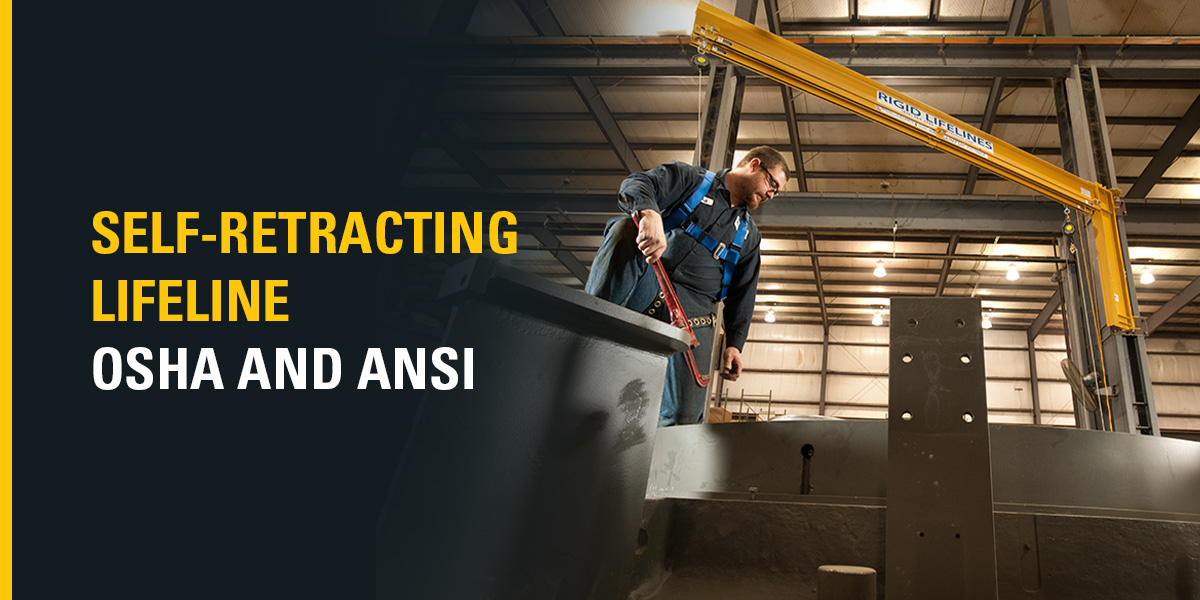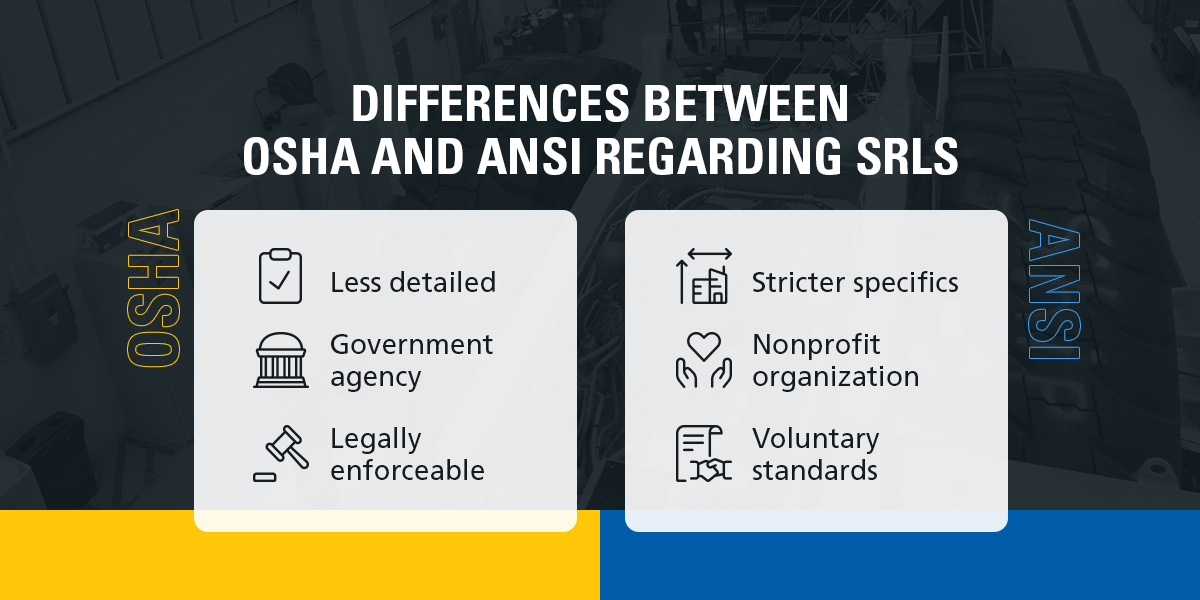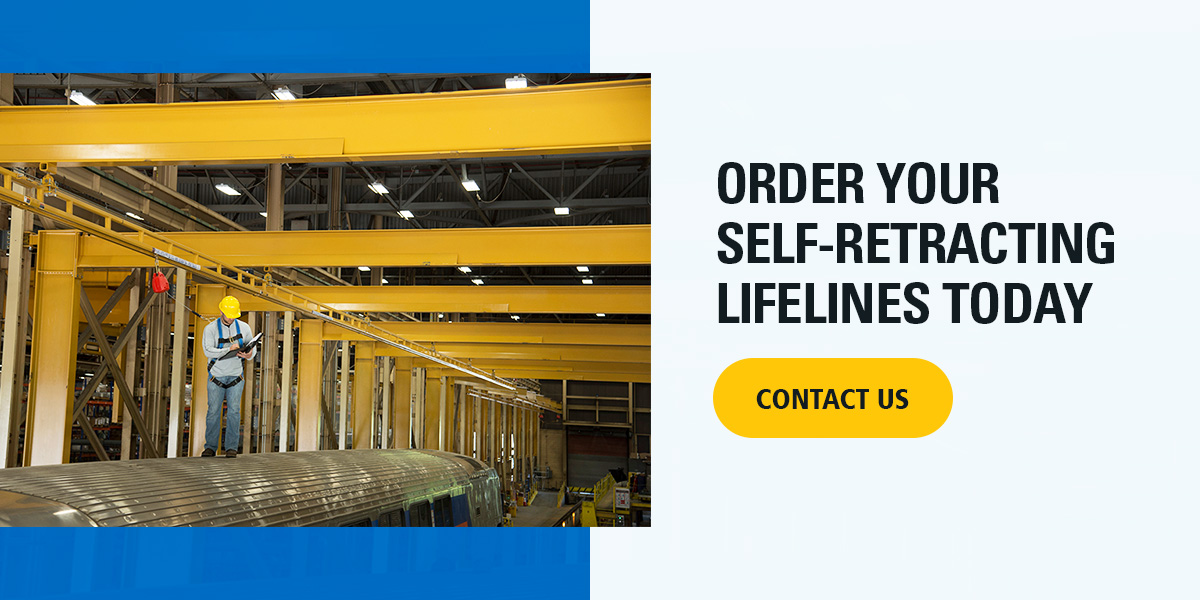
Self-Retracting Lifeline OSHA and ANSI
October 18, 2024
Safety protocols reduce the risk of accidental falls when working at heights. For example, the Occupational Safety and Health Administration and American National Standards Institute have established guidelines regarding self-retracting lifelines. These fall protection systems reduce workplace hazards, and adhering to OSHA and ANSI standards mitigates injuries and fatalities while preventing costly lawsuits and fines for employers.
Self-Retracting Lifeline Definition
A self-retracting lifeline or lanyard is a part of a fall protection system that connects a worker to an anchor point. It allows workers to move around while maintaining consistent tautness, reducing the risk of accidental falls. SRLs extend and retract like the seat belts in your car. If the wearer jerks forward or backward, an internal braking mechanism engages to stop their fall. The lifeline can move freely again once it is no longer under tension. SRLs are crucial for workplace safety and are subject to many regulations and requirements.
Fall Protection and Worker Safety Regulation
OSHA and ANSI are the two leading U.S. organizations that regulate fall protection and worker safety. While OSHA is a branch of the U.S. Department of Labor with access to research and information on how to prevent workplace incidents, ANSI is a private, nonprofit organization that oversees standards development completed by experienced industry leaders.
ANSI and SRLs
ANSI Z359 details the standards for fall protection. It describes a self-retracting lifeline and provides the safety criteria. It also categorizes SRLs into two classes — A and B. These classes define how far an SRL can unwind before it stops and how much force the device can apply to the wearer.
- Class A: These SRLs must have a maximum arrest distance of 24 inches. The peak arresting force must be below 1,800 pounds, with an average arresting force of less than 1,350.
- Class B: These SRLs allow a longer maximum arrest distance of 54 inches and an average arresting force of no more than 900 pounds. Classes A and B have the same maximum peak arresting force of 1,800 pounds.
ANSI provides additional functional and testing requirements to ensure compliance. These comprehensive requirements cover areas like tensile strength, retraction force, hardware components, locking function, fall indicators, and performance testing in various conditions. ANSI Z359.14 outlines the testing guidelines.
Finally, ANSI provides detailed directions for inspecting an SRL. These state how frequently owners should check these devices, who should perform the inspections, and the pass/fail criteria.
OSHA and SRLs
OSHA 1910.140(b) defines an SRL similarly to ANSI. OSHA 1910.140 covers the requirements and standards for personal fall protection systems. However, unlike ANSI, OSHA does not divide SRLs into classes. Instead, it gives minimum and maximum requirements that all SRLs must meet.
OSHA 1910.140(d)(1) lays out some of the base requirements for an SRL. This standard limits the maximum arresting force on a worker to 1,800 pounds and the maximum deceleration distance to 3.5 feet. It also states that the system must be able to support a worker in a fall event without contacting their neck and chin area.
SRLs that limit free-fall distance to two feet must sustain a tensile load of 3,000 pounds at full extension. If they do not, they must maintain a load of 5,000 pounds at full extension. Moreover, D-rings, carabiners, and snap hooks must sustain a tensile load of 5,000 pounds. They should maintain a minimum tensile load of 3,600 pounds without breaking, cracking, or becoming permanently deformed. Finally, under 1910.140(d)(2)(ii), personal fall arrest systems must limit free fall to six feet in a fall event.
Differences Between OSHA and ANSI Regarding SRLs

OSHA and ANSI provide standards related to fall protection, but there are four essential differences. It’s wise to familiarize yourself with both sets of guidelines for a thorough understanding.
1. Enforceability
OSHA sets legally enforceable federal requirements that ensure safe working conditions across various industries nationwide. In contrast, ANSI develops voluntary but crucial standards.
Corporate bodies and contractual parties can adopt ANSI rules as they choose, but there is no obligation. However, many safety professionals take ANSI seriously. Under its general duty clause, OSHA can require compliance with nationally recognized safety standards that address hazards. OSHA frequently cites ANSI Z359 for fall protection. Since ANSI incorporates nationally recognized standards, consider it supplemental to OSHA.
2. Regulatory Authority
OSHA is a government agency that enforces workplace safety laws, including SRL requirements. ANSI is a nonprofit organization that facilitates the development of voluntary consensus standards across various sectors. Compliance with ANSI standards is optional unless referenced by OSHA or adopted in a contract.
3. Specific Requirements
OSHA’s fall protection standards are less detailed than ANSI’s, which are generally stricter and more specific. ANSI outlines SRL classes, testing protocols, maintenance requirements, and user training recommendations. Organizations that comply with ANSI guidelines will likely meet and sometimes exceed OSHA provisions.
4. Updates and Revisions
OSHA updates its protocols based on legislative changes, industry feedback, and evolving safety practices. Committees of industry experts, manufacturers, and other stakeholders periodically review and revise ANSI standards.
Best Practices for ANSI and OSHA Compliance
Complying with ANSI and OSHA can be straightforward when you understand the requirements, implement adequate safety measures, and ensure ongoing training and maintenance. Here are some valuable tips to consider.
1. Learn the Standards
Familiarize yourself with fall protection and SRL requirements and adhere to them strictly. You can appoint an internal compliance department or outsource to a third-party professional if you lack the resources to maintain one in-house.
2. Conduct a Hazard Assessment
Conduct a thorough assessment of the work environment and identify potential fall hazards. Then, review your current fall protection systems and determine whether they meet OSHA and ANSI requirements.
3. Select Appropriate SRLs and Implement Use Procedures
OSHA and ANSI have different requirements for various scenarios. Your duty is to determine when to apply the appropriate standard. For example, you may need to ascertain the device class based on the intended use and ensure it has the proper load capacity for the users and conditions.
Create written procedures for SRL use, including how to attach and position them correctly. Also, ensure your SRLs are compatible with other fall protection equipment.
4. Provide Training
Education is vital for ensuring compliance with OSHA and ANSI. Offer comprehensive training sessions and make participation mandatory. In addition to learning when and how to use SRLs, educate workers on emergency rescue procedures and other safety protocols.
5. Use OSHA- and ANSI-Compliant Equipment
As an employer, you are responsible for providing safe working conditions, including equipment that protects employees. Inspect equipment and repair or replace broken devices when needed. Lastly, conduct periodic audits and update your policies for optimal compliance.
Order Your Self-Retracting Lifelines Today
Rigid Lifelines® has over 20 years of experience designing, manufacturing, and testing fall protection systems. Our self-retracting lifelines can keep your workers safe while complying with the OSHA and ANSI standards. We serve many industries and provide the accessories you need to configure your fall protection system to the application. Contact us now for quality products!

Categories
Share this post
Let us help you
Contact us today to find the perfect product fit for your job
